Podosome-like structures of non-invasive carcinoma cells are replaced in epithelial-mesenchymal transition by actin comet-embedded invadopodia
- PMID: 19656240
- PMCID: PMC3829022
- DOI: 10.1111/j.1582-4934.2009.00868.x
Podosome-like structures of non-invasive carcinoma cells are replaced in epithelial-mesenchymal transition by actin comet-embedded invadopodia
Erratum in
- J Cell Mol Med. 2010 Aug;14(8):2185
Abstract
Podosomes and invadopodia are actin-based structures at the ventral cell membrane, which have a role in cell adhesion, migration and invasion. Little is known about the differences and dynamics underlying these structures. We studied podosome-like structures of oral squamous carcinoma cells and invadopodia of their invasive variant that has undergone a spontaneous epithelial-mesenchymal transition (EMT). In 3D imaging, podosomes were relatively large structures that enlarged in time, whereas invadopodia of invasive cells remained small, but were more numerous, degraded more extracellular matrix (ECM) and were morphologically strikingly different from podosomes. In live-cell imaging, highly dynamic, invadopodia-embedded actin tails were frequently released and rocketed through the cytoplasm. Resembling invadopodia, we found new club-ended cell extensions in EMT-experienced cells, which contained actin, cortactin, vinculin and MT1-matrix metalloproteinase. These dynamic cell extensions degraded ECM and, in field emission scanning electron microscopy, protruded from the dorsal cell membrane. Plectin, alphaII-spectrin, talin and focal adhesion kinase immunoreactivities were detected in podosome rings, whereas they were absent from invadopodia. Tensin potentially replaced talin in invadopodia. Integrin alpha(3)beta(1) surrounded both podosomes and invadopodia, whereas integrin alpha(v)beta(5) localized only to invadopodia heads. Pacsin 2, in conjunction with filamin A, was detected early in podosomes, whereas pacsin 2 was not found in invadopodia and filamin A showed delayed accumulation. Fluorescence recovery after photobleaching indicated faster reorganization of actin, cortactin and filamin A in podosomes compared to invadopodia. In conclusion, EMT affects the invasion machinery of oral squamous carcinoma cells. Non-invasive squamous carcinoma cells constitutively organize podosomes, whereas invasive cells form invadopodia. The club-ended cell extensions, or externalized invadopodia, are involved in ECM degradation and maintenance of contact to adhesion substrate and surrounding cells during invasion.
Figures



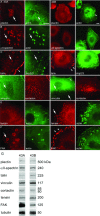
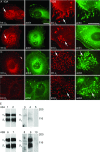
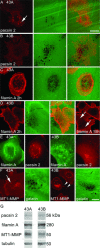
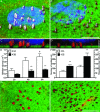
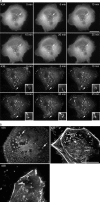

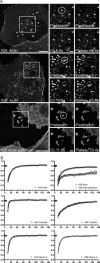
Similar articles
-
Dynamic membrane remodeling at invadopodia differentiates invadopodia from podosomes.Eur J Cell Biol. 2011 Feb-Mar;90(2-3):172-80. doi: 10.1016/j.ejcb.2010.06.006. Epub 2010 Jul 24. Eur J Cell Biol. 2011. PMID: 20656375 Free PMC article.
-
Signaling inputs to invadopodia and podosomes.J Cell Sci. 2013 Jul 15;126(Pt 14):2979-89. doi: 10.1242/jcs.079475. Epub 2013 Jul 10. J Cell Sci. 2013. PMID: 23843616 Free PMC article. Review.
-
Plectin deposition at podosome rings requires myosin contractility.Cell Motil Cytoskeleton. 2008 Aug;65(8):614-25. doi: 10.1002/cm.20287. Cell Motil Cytoskeleton. 2008. PMID: 18553359
-
CRP2, a new invadopodia actin bundling factor critically promotes breast cancer cell invasion and metastasis.Oncotarget. 2016 Mar 22;7(12):13688-705. doi: 10.18632/oncotarget.7327. Oncotarget. 2016. PMID: 26883198 Free PMC article.
-
Cellular protrusions--lamellipodia, filopodia, invadopodia and podosomes--and their roles in progression of orofacial tumours: current understanding.Asian Pac J Cancer Prev. 2015;16(6):2187-91. doi: 10.7314/apjcp.2015.16.6.2187. Asian Pac J Cancer Prev. 2015. PMID: 25824735 Review.
Cited by
-
The regulation of MMP targeting to invadopodia during cancer metastasis.Front Cell Dev Biol. 2015 Feb 2;3:4. doi: 10.3389/fcell.2015.00004. eCollection 2015. Front Cell Dev Biol. 2015. PMID: 25699257 Free PMC article. Review.
-
A network of spectrin and plectin surrounds the actin cuffs of apical tubulobulbar complexes in the rat.Spermatogenesis. 2013 Jul 1;3(3):e25733. doi: 10.4161/spmg.25733. Epub 2013 Jul 19. Spermatogenesis. 2013. PMID: 24381803 Free PMC article.
-
Modulating Tumor Cell Functions by Tunable Nanopatterned Ligand Presentation.Nanomaterials (Basel). 2020 Jan 26;10(2):212. doi: 10.3390/nano10020212. Nanomaterials (Basel). 2020. PMID: 31991896 Free PMC article. Review.
-
Regulation of invadopodia by mechanical signaling.Exp Cell Res. 2016 Apr 10;343(1):89-95. doi: 10.1016/j.yexcr.2015.10.038. Epub 2015 Nov 4. Exp Cell Res. 2016. PMID: 26546985 Free PMC article. Review.
-
Invadopodia play a role in prostate cancer progression.BMC Cancer. 2022 Apr 9;22(1):386. doi: 10.1186/s12885-022-09424-4. BMC Cancer. 2022. PMID: 35397545 Free PMC article.
References
-
- Cavallaro U, Christofori G. Cell adhesion and signalling by cadherins and Ig-CAMs in cancer. Nat Rev Cancer. 2004;4:118–32. - PubMed
-
- Weaver AM. Invadopodia: specialized cell structures for cancer invasion. Clin Exp Metastasis. 2006;23:97–105. - PubMed
-
- Linder S. The matrix corroded: podosomes and invadopodia in extracellular matrix degradation. Trends Cell Biol. 2007;17:107–17. - PubMed
-
- Lehto VP, Hovi T, Vartio T, et al. Reorganization of cytoskeletal and contractile elements during transition of human monocytes into adherent macrophages. Lab Invest. 1982;47:391–9. - PubMed
-
- Tarone G, Cirillo D, Giancotti FG, et al. Rous sarcoma virus-transformed fibroblasts adhere primarily at discrete protrusions of the ventral membrane called podosomes. Exp Cell Res. 1985;159:141–57. - PubMed
Publication types
MeSH terms
Substances
LinkOut - more resources
Full Text Sources

